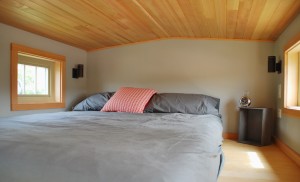-
A HUGE win for the Tiny House Movement!
Part 1 – The News
Incredibly good news from the movement in the USA! Tiny houses on wheels are now officially allowed, to live in full-time, in several areas in the Colorado Springs (Colorado) region. El Paso County changed the game and wishes to help other municipalities to follow suit!
Darin J. Zaruba: “It’s about the zoning!”
 Darin has fought hard for this for quite a while now, breaking the mold and help legalize smaller-living. He has been reaching out and talking to the county numerous times about leading the way in the USA, Colorado Springs being ‘nation’s capital city of the tiny house movement’. Darin, a local himself, organized the Tiny House Jamboree twice in Colorado Springs with an overwhelming amount of attendees, to create a momentum not just for the movement, but for the arising industry as well, and to bring those involved, like municipalities, together. He always said and believed that in order to allow and address the tiny house on wheels (THOW), we have to look and fight for (local) zoning changes instead of focusing too much on the coding.
Darin has fought hard for this for quite a while now, breaking the mold and help legalize smaller-living. He has been reaching out and talking to the county numerous times about leading the way in the USA, Colorado Springs being ‘nation’s capital city of the tiny house movement’. Darin, a local himself, organized the Tiny House Jamboree twice in Colorado Springs with an overwhelming amount of attendees, to create a momentum not just for the movement, but for the arising industry as well, and to bring those involved, like municipalities, together. He always said and believed that in order to allow and address the tiny house on wheels (THOW), we have to look and fight for (local) zoning changes instead of focusing too much on the coding.Coding and zoning in relation to a THOW. What’s the big deal?
Coding in the USA for residential use (IRC) is clear on one thing: it has to be on a foundation. So a THOW will never pass that code. No matter how well it’s built. Simply because it’s on wheels. Okay, so different code then. RV? The coding for a structure on wheels (RV) is clear on one thing as well: it’s for recreational use only. The building standards of an RV meet the requirements for recreational use only as well. Hence why they don’t allow you to live in it full-time. It’s a ‘lesser’ build.
Officially allowing a THOW to be used as your home (so combining the recreational set of wheels with permanent living) through the process of coding is, as Darin says: “like mixing oil and water”. Several tiny house advocates in the USA (Andrew & Gabriella Morrison, Zack Giffin, Macy Miller, BA Norrgard, and others) have presented the ICC (the board of IRC) with a proposal to change the language in the building codes. For small homes on a foundation. Also to change the code to allow variances in for example stairs – and loft sizes so a smaller space can be made live-able. Starting 2018. It got accepted and surprised the housing market. A step forward! Still, for a single plot of land, the local municipality has to accept this change in code first. They have the right to say: “No, we like to follow the 2012 building codes in our county or town”. Or: “We will accept the 2018 codes, but not the part with the loft sizes”. This means:
Several tiny house advocates in the USA (Andrew & Gabriella Morrison, Zack Giffin, Macy Miller, BA Norrgard, and others) have presented the ICC (the board of IRC) with a proposal to change the language in the building codes. For small homes on a foundation. Also to change the code to allow variances in for example stairs – and loft sizes so a smaller space can be made live-able. Starting 2018. It got accepted and surprised the housing market. A step forward! Still, for a single plot of land, the local municipality has to accept this change in code first. They have the right to say: “No, we like to follow the 2012 building codes in our county or town”. Or: “We will accept the 2018 codes, but not the part with the loft sizes”. This means:
A. that the THOW is still left out. And,
B. that every person who wishes to live smaller, legally, has to work their way through government to get their typical tiny home accepted. For every single piece of land.(In short, to keep it simple).
So now what?
Legalizing the THOW through coding has been proven to be a long, difficult and tiresome road. However, coding and zoning are always linked. The zoning dictates what kind of structure (coding) and use is allowed on each plot of land.
Hold…
So if a municipality says: “In this or this particular area in the county, the zoning allows you to use your certified RV or (by an official) certified DIY-THOW for permanent living”, you can live there, in your THOW, full-time and year-round?
Yes!
Ha! El Paso County changed the game
El Paso County changed the gameThat’s what El Paso County did. They assigned several areas in the county and changed the zoning to full-time smaller-living, also on wheels! That’s a game changer! Other major changes in legalizing smaller living before (like Walsenburg (CO), Portland (OR) or my own home country The Netherlands) often have or had compromising limitations. Like taking the home off of its wheels and putting it on a foundation, or no zoning change but only for a limited amount of time and as a project, or only in someone else’s backyard. That’s not the case now.
However, there’s fine print here too. Wheels and hitch has to be removed or(!) covered for example. Safety in building has been taken care of as well. They do not allow well intended but unsafe structures. The Gazette: “Under the amended code (read ‘rule’ in this case), a resident can buy a tiny house from a manufacturer that builds to a specific set of nationally recognized standards or build their own and have it certified by a licensed structural engineer”.
Fine print, yes. For safety reasons mainly. But it’s not temporarily. It’s not in someone else’s backyard, and you don’t have to tear your THOW apart.- Build it safe, have it checked by those who are officially assigned to do so.
- Or have it build safe by someone else, who’s certified or can have it checked officially as well.
- Meet the utility requirements like all homes have to in the area.
- Skirt the home
- And you can park your THOW and live in it legally! Year round!
This is why this is such a huge breakthrough. THOWs are practically treated the same way as any other known structure we call ‘home’ as far as legality, in an inclusive way. This finally opens up the housing market to live legally in tiny houses on wheels! El Paso County is passionate on leading the way for others to follow suit!
Part 2 – My personal thoughts on this
Why I think this game changer is important
I’ve been a huge advocate for breaking the mold of the housing market for several years now. In my opinion we, as human beings, should be able to choose a home that fits our needs, instead of adjusting our lives to the standard sized available homes. Which often include 30 year mortgages, big (utility and insurance) bills, and stuff and space we hardly ever use. I frequently wrote about this here on my blog, and also in the book Turning Tiny.
Living smaller and debt free changed my life completely, but the availability and legality of living-smaller have been major issues. A THOW is one way that could fit someone’s and this society’s needs. But there are and should be more ways. Think a cabin, a TH on a foundation, or a well build gypsy wagon style home for example, and more. Your pick! It’s described as ‘human scale living’. The reason why this approach, changing the zoning instead of focusing too much on the coding of the structure, is so important in my opinion is because it allows for this wider variety to emerge and present itself to society. Which is truly opening up the housing market for a simpler, debt free, and cleaner way of living.
No! To the same cramped approach
I’ve seen and follow TH movements worldwide and often bump into the following approach: trying to legalize THOWs through creating a very specific description of the structure. In posts, comments, talks, meetings, and on websites in my own country (The Netherlands) strong and important voices have turned down and excluded smaller or bigger homes on wheels, or homes without a loft, or homes not made entirely out of natural materials, or homes with normal electricity hookups, from participating in the movement. Just for not being a, in their mind, conventional THOW.
Huh?!?
We don’t even have a set of official rules yet (top down) so we have a chance to make a change, and we’re already limiting ourselves in very rigid ways (bottom up)? That’s not opening up the housing market! That’s just helping with adding yet another rigid box to the already cramped set of codes. There are other ways to set an example.
INclusion instead of EXclusion
Imagine a size line. From zero to let’s say a 1000 sqf. Lots of variety and choice to live legally from approximately 400 sqf and up. Great homes or apartments and often times also only available if you qualify for a loan or a mortgage. Alas, not much to be found smaller than that. But one little dotted island somewhere around the 200 sqf mark. All alone. With a looooong set of requirements on lofts, trailers, wheels, grey water, use of materials, on-off grid, composting toilet, etcetera. That’s what some are aiming for in my home country and it happens in other countries as well, but working this detailed, without probably even being aware of the consequences, creates exclusion. It’s not, in my honest opinion, ‘dotting’ the landscape with more variety for those who wish to live smaller and wish to make the home fit their basic needs. It’s nothing more than projecting the same cramped approach we’ve been dealing with for years on a slightly smaller dwelling.
If cramped approaches would work, you wouldn’t hear me say anything. But it has been proven to be inflexible in an ever changing society. It’s again about exclusion instead of inclusion of those with simple life wishes. And not just exclusion of people, or a THOW without a loft. It’s with everything, in general. We don’t know what we know years from now. There may be new building techniques, or even better and cleaner materials. Set the standard now, too detailed, and we wouldn’t be able to use them for quite a while even when they’re being made available to us. Because the building code says… We will be stuck in the exact same place that we’re stuck in now. Fighting for change! The approach should be, in my opinion, about setting the intention first and foremost, with room for personal preferences and room for adjustment as we grow.
If we set up detailed rigid rules and requirements first, it costs a lot of time, not to mention money, to go through all those processes, every single time a new ‘box’ arises. Whether it be a type of home or a type of natural glue.
I say YES to a certain amount of building standards, absolutely! For safety reasons, especially if it’s about to go on the road. Let’s use that knowledge. But let’s stop the exclusion. It’s not helping us moving forward.If we wish to open the housing market to a more attainable, simpler, and a more environmental friendly way of living, we shouldn’t focus too much on just this one home, as the current perfect tiny home that fits the image of one specific structure (on wheels), being a part of a project, built in a certain way. Even if this image is so darn cute and even if it seems to be ‘a step in the right direction’.
Congrats!
I’m therefore personally very happy that the Pikes Peak region, where I’m staying most of the times while in the USA, changed the game and chose a different approach, the approach of inclusion. And Darin has fought, as well as others in the movement and industry, hard for this! I will continue to do so as well.
So, congrats! To him, and to the movement!
Used sources:
- The articles of the Gazette that came out with the news:
El Paso County welcomes tiny homes in unincorporated areas
Recent land-use changes could help Pikes Peak region become a hotbed for tiny homes - Darin Zaruba
- El Paso County, Colorado
- Lots of meetings, visits, talks, and research
- My head, heart, and common sense











 Darin has fought hard for this for quite a while now, breaking the mold and help legalize smaller-living. He has been reaching out and talking to the county numerous times about leading the way in the USA, Colorado Springs being ‘nation’s capital city of the tiny house movement’. Darin, a local himself, organized the Tiny House Jamboree twice in Colorado Springs with an overwhelming amount of attendees, to create a momentum not just for the movement, but for the arising industry as well, and to bring those involved, like municipalities, together. He always said and believed that in order to allow and address the tiny house on wheels (THOW), we have to look and fight for (local) zoning changes instead of focusing too much on the coding.
Darin has fought hard for this for quite a while now, breaking the mold and help legalize smaller-living. He has been reaching out and talking to the county numerous times about leading the way in the USA, Colorado Springs being ‘nation’s capital city of the tiny house movement’. Darin, a local himself, organized the Tiny House Jamboree twice in Colorado Springs with an overwhelming amount of attendees, to create a momentum not just for the movement, but for the arising industry as well, and to bring those involved, like municipalities, together. He always said and believed that in order to allow and address the tiny house on wheels (THOW), we have to look and fight for (local) zoning changes instead of focusing too much on the coding. Several tiny house advocates in the USA (
Several tiny house advocates in the USA ( El Paso County changed the game
El Paso County changed the game


